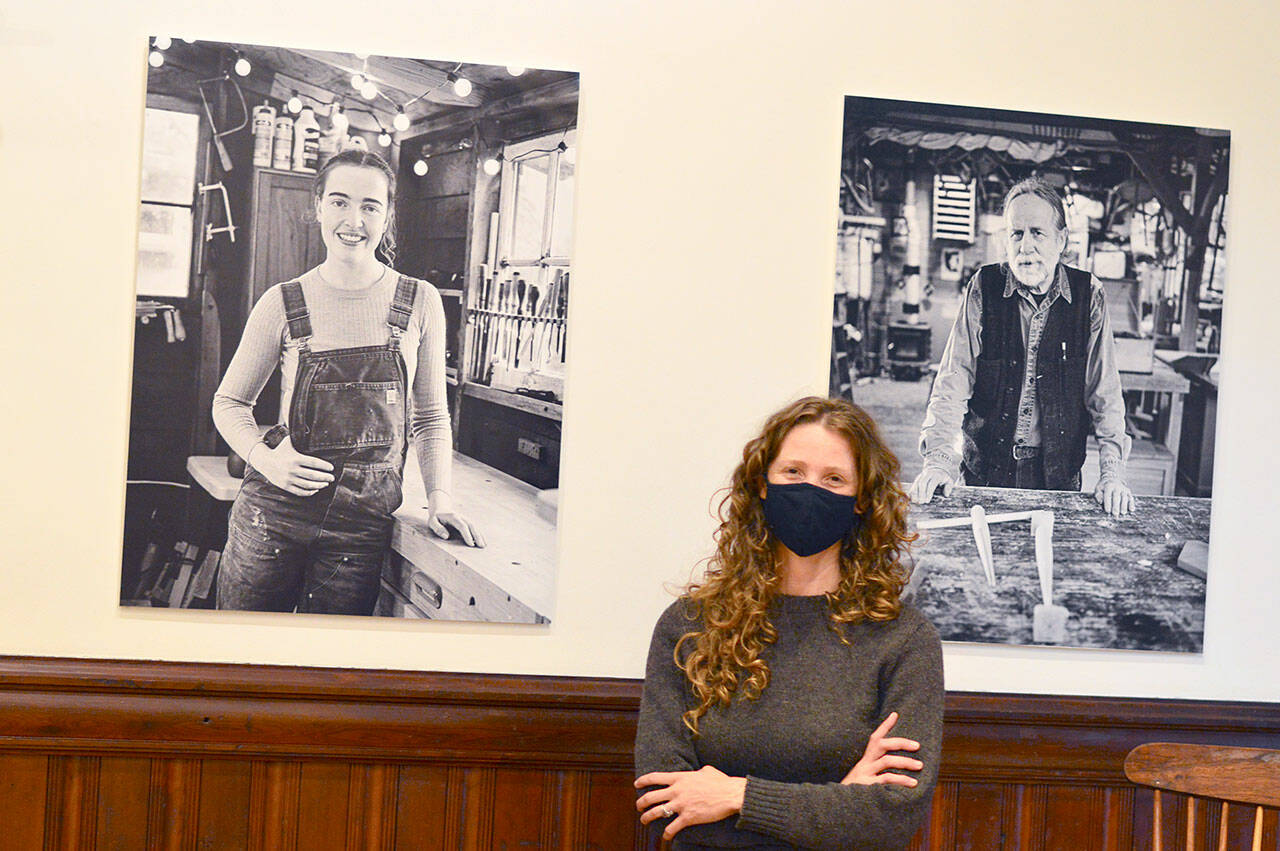PORT TOWNSEND — Walking into the newly reopened Jefferson Museum of Art & History, the visitor finds a splash — and a spray — of blue, white, black and bright tomato red.
These are paintings by local artist Stephen Yates, who “has such a sense of adventure,” said Shelly Leavens, who recently led a walk through the museum.
Yates’ abstract works, made with spray paint, are “so different from what people expect to see. I love that,” she added.
Leavens, executive director of the Jefferson County Historical Society, has opened the doors of the museum at 540 Water St. after an 11-week closure.
The plan was to have newly remade wooden doors at the front entrance, but those have been delayed a couple of weeks, she said.
The museum’s marquee exhibition, however, is right on time.
Simply titled “Wood,” it showcases sculpture, carvings, furniture and even a chest filled with the hand tools Horace Tucker (1839-1938) used to build the entire Rothschild House in Port Townsend.
Rocking chairs, a cherrywood music stand, red cedar sculptures and poplar hanging lights all share the space.
Downstairs in the Women’s Jail Gallery, a row of wood turner Helga Winter’s bowls, each made of madrone, awaits. And on the walls above all of this wood, photographer Jeremy Johnson’s large black-and-white portraits of the artists gaze out.
“Wood” will stay on display through May at the museum, which is open from 11 a.m. to 4 p.m. Thursdays through Sundays. For information about it and other historical society activities, see JCHSmuseum.org or phone 360-385-1003.
Leavens and her crew plan an opening reception for the “Wood” show, complete with the participating artists who can make it, on April 2. The event from 4 p.m. to 6 p.m. will have live fiddle music, a demonstration by woodworker Annalise Rubida and “general merriment,” Leavens promised.
Rubida is part of the next generation of artists whose medium is wood.
Her work and her portrait stand in the gallery beside that of Steve Habersetzer, her teacher. Rubida spent her childhood in rural Chimacum and in Port Townsend’s North Beach, then went traveling to New Zealand and Europe, then returned to study at the Port Townsend School of Woodworking at Fort Worden.
Today Rubida teaches at the school, works with fellow artist Seth Rolland and has her own commissions.
“I don’t think I could work this hard if there wasn’t a constant source of inspiration … I learn a hundred different things from each person,” she tells author Jenny Westdal in the “Wood” exhibition’s catalog.
Beside the work of Rubida and Habersetzer are Tucker’s tools.
Artifacts from the Port Townsend of 160 years ago, these are the implements that belonged to the builder of the Tucker family home at 706 Franklin St., the Pink House beside the Port Townsend Library on Lawrence Street and St. Paul’s Episcopal Church at 1020 Jefferson St. It’s the oldest church in Port Townsend, and the one where Tucker married his wife, Mary Jane Caines, in 1867.
Tucker’s best-known project is the Rothschild House on the bluff at Franklin and Taylor streets. The Jefferson County Historical Society manages it as a state park and will reopen it in May.
This exhibition, Leavens said, speaks of wood’s role in human lives over the centuries. She, along with Westdal and co-curators Ann Welch and Laura Reutter, wanted to also show the possibility and preciousness of this natural resource.
Port Gamble S’Klallam tribal member Brian Perry’s work is here, including his “Salish Weavers Spirit” sculpture of red cedar bark and his blue-black-cedar “Heron Sculpture.”
Nearby in the gallery stands Rolland’s “Ghost Tree,” alongside his furniture creations, such as his fan-shaped music stand.
“Seth’s pieces are the most contemporary, the most sculptural,” Leavens said.
“It’s really fun to juxtaposition something sculptural with something extremely functional,” to show the beauty in each.
The Jefferson Museum of Art & History has yet another display in the downstairs gallery: a first look at the New Jefferson Museum Project.
The historical society plans an update of the 1892 edifice housing the museum, to accommodate new exhibitions and to become more accessible to visitors with mobility challenges.
Interpretive panels on the future possibilities are in what’s known as the Medical Examiner’s Gallery.
“We’re re-envisioning what an art and history museum can be in our community,” Leavens said.
________
Jefferson County Senior Reporter Diane Urbani de la Paz can be reached at 360-417-3509 or durbanidelapaz@peninsuladailynews.com.

